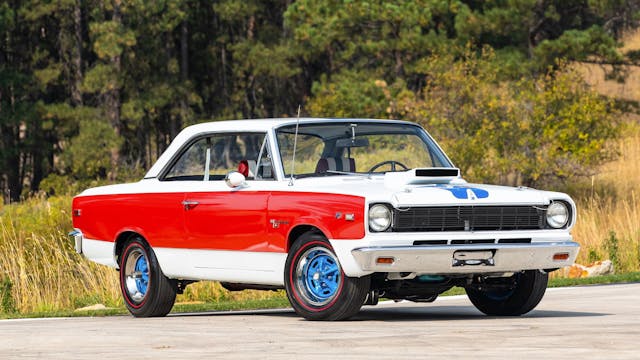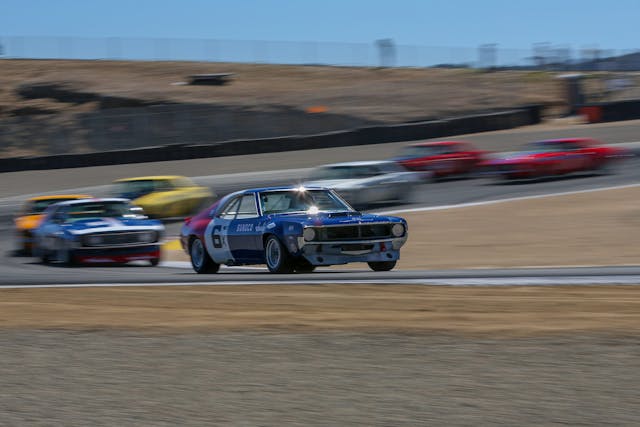5 of the most American vehicles to wear red, white, and blue
On this Fourth of July, we’re taking a look back at some of the most America-centric vehicles ever sold. These are the cars and trucks that leave no doubt as to their origin and purpose.
You might think that it would be easy to just drape the stars and stripes over any car, but the U.S. flag code frowns on that practice. That’s why one of the Corvette’s crossed flags uses a Chevy Bowtie and a fleur-de-lis rather than the U.S. flag. However, that hasn’t kept manufacturers from showing their patriotism in other ways.
As you’ll see by the last car in our list, it’s up to interpretation … and it runs deeper than a couple coats of paint.
Racing livery AMC Javelins

AMC had “American” right in its corporate name, so it’s no surprise that it raced its sporty Javelin in a livery inspired by the stars and stripes. The Javelins that Mark Donohue raced on the road courses all across North America wore bold swaths of red, white, and blue and a similar paint scheme was offered to the public. Donohue’s 1971 effort in a tri-colored Javelin like the one seen at the top of the page gave the brand its first Trans Am series victory in 1971, and George Follmer backed it up for the brand in 1972.
1969 AMC SC/Rambler

AMC offered another red, white, and blue racer at the same time as its Javelin pony car was tearing up road courses, but this one prowled the streets and drag strips. The Hurst SC/Rambler used a 390-cubic-inch V-8 that breathed through an aggressive hood scoop to churn out 315 hp. The wilder of the two patriotic paint schemes, the one shown here is known as the “A” trim, distinguished by its red flanks. The SC/Rambler package also included subframe connectors, larger diameter sway bars, and disc brakes, so don’t let anyone tell you that muscle cars were only about straight-line speed.
1972 Ford Mustang Olympic Sprint

Few events bring a country together like the Olympics, and Ford’s celebration of the 20th Olympiad included Sprint packages were offered for the Pinto, Maverick, and Mustang. The blue rocker panels and hood stripes are accented by red pinstripes, and twin stars-and-stripes shields adorn each quarter panel. Inside, white vinyl seats received blue cloth inserts with red piping inserts, while the door panels were all blue. The darker rockers really fit these bigger fastback Mustangs and give them a sleek look.
1975 GMC Indy 500 Edition

It may seem a bit strange that an open-wheel car race has an official truck, but the Indy 500 is one of America’s most loved and historic races, and pickup trucks are perhaps the most quintessentially American of vehicle classes. The resulting mashup gave us strobing blue and red stripe graphics on a white background—a rather flashy look from GMC, as if the brand had pulled a page from the early ’70s Mopar muscle playbook. That’s OK by us. They’re a rare sight today, but fans of GM square-body pickups have created some impressive homages lately, keeping these Indy 500 Editions alive for new fans.
Dodge Viper (any of them)

There’s something inherently American about Dodge—the mid-range brand from the smallest, scrappiest member of the Big Three—building a bespoke engine and chassis for a no-nonsense sports car as rowdy as the Viper. Even though Dodge did have input from Lamborghini on casting the huge aluminum block, the resulting engine, which grew to more than 500 cubic inches, could hardly be more American. It’s basically a race small-block V-8 with two extra cylinders, and it managed to power the Viper to lap records across the globe. Weak sales proved downfall of the unapologetic and unforgiving Viper, since Dodge refused to offer an automatic transmission (to its everlasting credit). Even though the Viper is no longer in production, the fact that the final generation of the Viper was its most gorgeous and highest performing offers some solace.
As with any list, there are always some holdouts that don’t get their due. There are plenty of Bicentennial editions that we could have added to this list, but which ones would get the nod? You tell us: Which car or truck was (or is) the most unabashedly American?



Red, White and… But you put a YELLOW Viper in the article, WTF?
You forgot that in 1972, when Ford sold the red, white, and blue Mustang, they also did the same treatment on the Maverick and the Pinto! Or were you trying to forget those?
John Greenwood Corvettes. Always red, white and blue!
Didn’t Dominos Pizza run red, white and blue delivery cars? AMC’s I think.
Wonder what US manufacturers (and maybe even Stellantis) will come up with for the USA’s 250th anniversary in 2026…
Know one called out the Dodge Spirit of 76.
A bit of a flop but wasn’t yellow.
Don’t forget the mighty Pintos and Mavericks that came in RWB. Maybe in 76 for the Centennial?
Hey, What about the “Spirit of 76” Duster?
Two that I can think of off the bat….the “Stars and Stripes” of Indycar (AJ Foyt Racing) and thought not a car but it is a transportation vehicle: the Easy Rider “chopper”.
My first thought, Easy Rider
I am a Canadian ,and a very proud Sc/Rambler owner in all of it’s A scheme glory .I post it with my Happy 4th of July wishes to all my American friends and family every year !